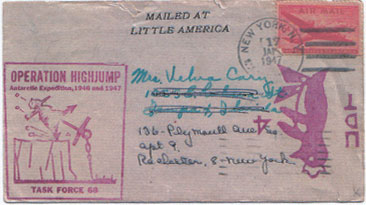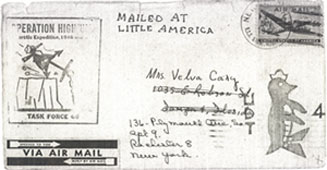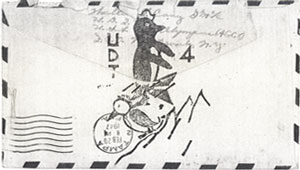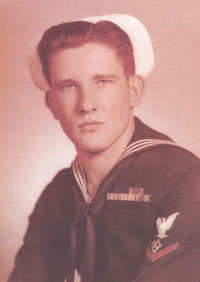|
In 1995,
naval historian and OPERATION HIGHJUMP postal history
specialist Joseph Lynch, Jr. examined various research group cachets
used on Highjump mail and published his results in a most interesting
article of the JUL-SEP issue of the Ice
Cap News, the official journal of the American
Society of Polar Philatelists. In his column, Joe stated
that "Perhaps unique in the realm of Antarctic cachets
is the Underwater Demolition Team 4 cachet." Joe has since
indicated that his research of the UDT 4 cachets was originally
conducted in the mid-70's and that, quite frankly, he had always
been suspicious of the very existence of the cachets since he had
only seen a black-and-white photocopy of them on a single occasion.
In September 2004, the existence of these cachets was authenticated
when the daughter of Walter Cary sent a beautiful example to me
... the UDT 4 cachets on cover. Supporting documentation included
personal letters to Walter's mother, a diary, newspaper clippings
and photographs. I hope you enjoy reading Walter's story and supporting
documentation as it pertains to the UDT 4 cachets, the "Holy
Grail" of Operation Highjump postal history.
Gary Pierson
|
Walter
L. Cary was attending West End High School in Birmingham, AL, when he
enlisted in the Naval Reserve. He was just 17 years old on this day in
July, 1944. He immediately volunteered for underwater demoliton training
and upon acceptance into the program, Walter split his training between
Camp Peary, VA. and Fort Pierce. Walter Cary was preparing to sail with
his demoliton team to participate in the invasion of Japan when the war
suddenly ended. As a result, Walter and his mates sailed to Hawaii for
more training before going to Japan to help clear the waters of mines
and underwater navigation hazards. He spent nearly a year in Japan before
returning to the states whereupon he enlisted in the regular navy for
two years.Walter was hand-picked from a team of demolition experts to
participate in OPERATION HIGHJUMP. The team,
UDT 4, consisted of 26 men and five officers.
Their assignment was to keep "the channel of an Antarctic harbor"
ice-free during the expedition. In a telephone call to his mother, Walter
explained how his team would have to explode an estimated six square miles
of ice daily to carry out their mission.
Another
young man from Tampa FL, Mike O'Conner, would participate in OPERATION
HIGHJUMP. O'Conner enlisted in the US Navy in December,
1942, just before he began his junior year at Hillsborough High School.
Following boot camp, he was stationed aboard the Naval Transport USS
ELMORE. Mike went on to participate in seven major engagements
in the Pacific Theater and in the liberation of the Philippine Islands.
He was coxswain of one of the landing craft operating from the USS
ELMORE on numerous beachhead assaults. In late 1946, Mike
found himself in charge of a group of men aboard the USS
PINE ISLAND that was responsible for maintaining the
platforms on the forward deck of the ship which were used to carry three
PBM patrol planes, a small scout plane and two helicopters.
The Letters . . . The Diary
 MALA Type B /
Hand Cancel Type II / UDT 4 Cachet
MALA Type B /
Hand Cancel Type II / UDT 4 Cachet |
Mrs.
Velva Cary, Walter's mother, was a widow by the time her son "sailed
with Byrd" to the Antarctic. Walter was only 7 years old when
he lost his father. Although addressed to the family home in Tampa,
this letter had to be forwarded to Rochester, NY, where Velva was
staying with her daughter (Walter's sister). |
NOV
27, 1946 |
|
Underwater
demoliton team four went aboard MOUNT
OLYMPUS, flagship for Antarctic operation. |
NOV
28, 1946 |
|
The team was
given a 4 day pass over Thanksgiving holiday. |
NOV
29, 1946 |
|
Twenty seven
husky dogs came aboard. Had a ship dance and beer party. |
|
NOV
30, 1946 |
|
All loaded ready
for OPERATION HIGHJUMP. |
DEC
1, 1946 |
|
Correspondents
came aboard. |
|
DEC
2, 1946 |
|
Admiral Richard
E. Byrd came aboard ship. Went ashore around 12:30. We shoved off
from pier 3 Norfolk VA at 1300. Cold and heavy waves. |
DEC
3, 1946 |
|
Around Cape Hatteras
and now have calm sea. |
DEC
4, 1946 |
|
Second day out,
team is working with crew. I am on fire control. |
DEC
5, 1946 |
|
NORTH
WIND having trouble, pulled into Jacksonville Florida
for repairs. Passed Cuba and Haiti. |
DEC
6, 1946 |
|
Weather fine,
but hot. Continued working. |
DEC
7, 1946 |
|
Pulled into Colon
Bay Panama -- took off sick CBS correspondent and started through
the canal. Also received mail. |
DEC
8, 1946 |
|
Starboard section
had liberty. Loading ship with more supplies. |
DEC
9, 1946 |
|
Starboard side
had liberty again. Borrowed liberty card and went ashore. |
DEC
10, 1946 |
|
Sailed from Balboa
docks -- heading for Scott Island. |
DEC
11, 1946 |
|
Polliwog day
and we gave the Shell backs "hell". |
| DEC
12, 1946 |
|
Crossed the
Equator at 0000" Longitude and Latitude 84-43 SW. |
DEC
14, 1946 |
|
Nothing new.
Weather fine. |
DEC
17, 1946 |
|
Rough weather.
Course 210"-SSW. |
DEC
18, 1946 |
|
Good sailing.
Had GQ today. Crew has been getting lectures every night on Antarctic
life. |
DEC
19, 1946 |
|
Still getting
a workout on training sites. |
DEC
20, 1946 |
|
Rough sea, rain
and large swells. |
DEC
21, 1946 |
|
Refueled at sea
from USS CANISTEO. |
DEC
22, 1946 |
|
Dressed in foul
weather gear. Getting rain and colder. |
DEC
24, 1946 |
|
Christmas Eve.
Had a Xmas show. Gets dark only three hours a day. |
DEC
25, 1946 |
|
Christmas Day.
Thinking of home. Had a swell chow. |
|
MERRY
CHRISTMAS
FROM OFFICERS AND MEN OF THE
USS MOUNT OLYMPUS |
|
DEC
26, 1946 |
|
Sighted first
Sperm whales, also first ice-berg. Weather cold and heavy fog. |
DEC
27, 1946 |
|
Visibility bad,
-- cold and damp. |
DEC
28, 1946 |
|
Ice-bergs all
around. Radar doing 4.0 job. |
DEC
29, 1946 |
|
Crossed Antarctic
Circle at 2000 last night. |
|
DEC
30, 1946 |
|
Scott Island,
only 600 miles to Little America. Lay at drift while NORTHWIND
proceeded to find a way through ice field. Our position at 0200 -
67" South --- 174" West.. |
DEC
31, 1946 |
|
The
PBM is still missing, feared lost. We are now in the "Ross
Sea." |
|
Authentication arrives . . .
First
mention of the Type I UDT 4 Penguin Cachet arrives in a letter
to Walter's mother dated JAN 12, 1947.
"How do you like
my penguin on the first page. I made him the other day."
|
JAN
1, 1947 |
|
The
Mighty "O" has sprung leaks from hitting the ice. Sea
very calm. |
|
JAN
2, 1947 |
|
We
moved only 30 miles today. Ice is very thick. The MERRICK
sprung a bad leak. Taking in 120 gallons of water a minute. |
|
JAN
3, 1947 |
|
We
started through the ice pack again but had to stop while the NORTHWIND
went back to help the submarine SENNET
out. You can now see large mountains of ice. |
|
JAN
4, 1947 |
|
At
this writing, there is no official information as to when we will
be able to start forward again. During the 24 hours ending 2000,
January 3, we made good only 5 miles. The SENNET
has been taken back to Scott Island by the NORTHWIND.
Bad weather still prevents any search for the missing
plane. |
|
JAN
6, 1947 |
|
The
NORTHWIND had to return to cut the MERRICK,
YANCEY, and
the OLYMPUS away from the ice. She took
the ships to more open water. Then she went back to the SENNET.
We are now about 100 miles from Scott Island. |
|
JAN
7, 1947 |
|
Yesterday
the NORTHWIND finished taking the SENNET
north beyond the ice pack, and came back to lead us southward. For
24 hours ending at 2000 yesterday we made good 78 miles. |
|
JAN
8, 1947 |
|
Despite
many bangs and bumps, we are going steady forward at 0400, the NORTHWIND
ran into a floe estimated to be at least 30 feet thick, and we had
to turn back 15 miles to an open "Lake", where we are
until we find a way through. From the Western Groups we learned
that two PBM planes from the CURRITUCK
took off to try to find a way through the ice for us, but were forced
back by bad weather. |
|
JAN
10, 1947 |
|
We
are still within a few hundred feet of the same place, or so it
seems. At last, about 0830 a PBM flew over scouting a way for us
through. We went ahead about 2 miles then had to stop. Ice too thick. |
|
JAN
12, 1947 |
|
The
PBM plane known as "George II" left the PINE
ISLAND at 0200 (our time). Shortly before 0700,
we heard from messenger in quick succession from the PINE
ISLAND stating that "George II" had found
the burnt wreckage of "George I"
at latitude 71" 03' S., longitude 98" 47' W., and saw
men alive. The downed plane was first sighted by W.A. Long of North
Carolina. It had crashed on a plateau 1000 feet high, 8 or 10 miles
from the edge of open water -- we got underway again yesterday at
0920. Went through much ice, and had to make many stops. At least
twice the NORTHWIND circled back to help
us out. At 2330 we were still moving, making good about 18 miles.
Our position at 2000 was Latitude 70" 41' S, Longitude 178"
34' W. |
|
JAN
14, 1947 |
|
At
0800 yesterday there was very little ice, now even at 1000 the water
was again full of ice cakes. As on the previous day, there was enough
open water so that we could go right along at a speed of 6 knots.
For 24 hours ending at 2200 yesterday, we made good 134 miles and
reached approximate position: Latitude 74" 43' S. - Longitude
179" 44' W. The depth of the water was 203 fathoms. Little
America is 315 miles away, and have 144" true. |
|
JAN
15, 1947 |
|
The
famous Ross Sea Barrier was sighted, according to the official log,
at 0005 we reached it at the peninsula on the north side of Discovery
Inlet. |
|
JAN
16, 1947 |
|
The
NORTHWIND found the Bay of Whales at
0835. Entering the bay the NORTHWIND found
it frozen over. She spent the day breaking ice. The current washed
the ice out into the Ross Sea for us to look at -- as if we haven't
seen enough. The Bay of Whales is 400 yards across the mouth and
2 1/2 miles deep. Six years ago it was 1 1/2 miles wide at the mouth
and five miles deep. |
|
JAN
17, 1947 |
|
The
NORTHWIND, up to last evening, had broken
an estimated three square miles of ice in the bay. A party of nine
officers, two correspondents, and a scientist went ashore. Came
back very sun burned even though it was a cloudy day. |
|
JAN
18, 1947 |
|
The
YANCEY went into the Bay of Whales. She
moored to four dead men, and started to unload cargo onto the bay
ice which is about 10 to 15 feet thick. First came the cargo-handling
equipment, weasels, trucks, jeeps, caterpillars, go devils and sleds.
The road to the top of the barrier was built over a crevice and
trails were marked with flags. The first sled moved over the pressure
ridge at 1600. |
| | |
|
JAN
19, 1947 |
|
The
MERRICK was scheduled to move into the
bay and start unloading. It is now considered safe for two ships
to unload at once. There is a large open space, large enough to
maneuver if the ice should break up. The MERRICK
was tied up where the NORTHWIND had been,
to the west of the YANCEY. There has been
trouble in pulling loads up the Barrier, but not as much as expected.
Special treads have been put on tractors to enable them to pull
in the snow. |
|
JAN
20, 1947 |
|
Mail
went out from Little America by the NORTHWIND
at 1630. She had sixty bags. -- Base camp has reported that 18 tents
are up and a 30 foot x 15 foot x 7 foot ice box for the base camp
has been completed. The refrigerator is built of ice blocks and
took 12 hours to construct. |
|
JAN
21, 1947 |
|
A
man, not yet 17, was killed yesterday on the ice while loading a
sled. Went on board the MERRICK. Will
help build the base camp. |
JAN
22, 1947 |
|
The
team is working in two shifts, twelve hours each. Working on the
"Hill" is very tough and cold. |
JAN
23, 1947 |
|
All
ships had to leave the ice barrier because an iceberg was threatening
to block the mouth of the bay. |
|
The UDT 4 Type II Cachet
NEW
YEAR'S DAY, 1947. In a letter to his mother, Walter
mentions the rubber stamp applied to the top of the first page.
This authenticates the existence of another UDT 4-designed cachet,
but the creator remains anonymous ...
"The stamp on
the front page was made by one fellow in the team. Not bad."
|
JAN
24, 1947 |
|
Return
to the ice barriers and started working again on the ice. |
JAN
25, 1947 |
|
The team transferred
back to the MOUNT OLYMPUS from the MERRICK. |
|
JAN
26, 1947 |
|
Had General
Service on the ice. Believed to be first public worship offered
from Antarctica. Word is expected any moment from the PHILIPPINE
SEA that Admiral Byrd has taken off. |
|
JAN
27, 1947 |
|
The plane crash
survivors are now aboard the PHILIPPINE SEA
-- Bad weather in the area of the PHILIPPINE SEA
has deferred the flight of the R4D's and the arrival of Adm. Byrd. |
|
JAN
28, 1947 |
|
As the bay
ice, to which we were tied, began to break up, the whistle blew,
we abandoned our dead men and the bay and were soon going round
and round in the sea again. The NORTHWIND
on way back with mail. |
JAN
29, 1947 |
|
The base camp
has requested bread and men. The MERRICK
will supply them with 25 men and bread as needed. |
|
JAN
30, 1947 |
|
As the berg
moved out to sea and weather at both ends became good, the MOUNT
OLYMPUS, MERRICK and YANCEY
were ordered into the bay to tie up and two planes, carrying Adm.
Byrd, were ordered to take off from the PHILIPPINE SEA
for our air strip on the base camp. Our second ice breaker is now
halfway between the equator and Scott Island. |
JAN
31, 1947 |
|
Admiral Byrd
arrived. Six planes landed. They are C47, making a world record
of large air craft taking off from a carrier. |
|
FEB
1, 1947 |
|
Again the team
transferred off the OLYMPUS to the MERRICK
and YANCEY. We came by a LCM. Having a
snow storm and rough water. Visibility about 20 feet. |
FEB
2, 1947 |
|
Started unloading
the explosives aboard the MERRICK. |
FEB
3, 1947 |
|
Making
experiment on the ice by blasting holes into the ice barriers. Had
"E" rations for chow. |
|
FEB
4, 1947 |
|
Carried out
more experimental work. Largest charge used was 1200 lbs. I went
swimming in the Bay of Whales. Water temperature was 27" above
zero. |
|
FEB
6, 1947 |
|
Had team picture
made. At a press conference granted yesterday, Adm. Byrd summarized
the accomplishments of OPERATION HIGHJUMP
to date as follows: Bay discovered: Four good sized bays have been
discovered. One of these discovered by the Eastern Group along the
Walgreen coast, is 180 nautical miles north and south, by 120 nautical
miles east and west. Three other sizable bays were discovered by
the Western Group. Islands discovered: At least 20 islands have
been discovered. They are comparatively small but substantial. They
constitute approximately 125,000 nautical square miles of continental
territory unknown until now. Ocean area: About 75,000 square miles
of unknown ocean area have been flown over and observed. Mountain
Groups Discovered: About three or four mountain groups have been
discovered. It is explained that a mountain group differs from a
mountain range in that the group is shorter, does not extend as
far as the range. Mountains Discovered: About eight new mountain
ranges have been found. They range from heights of 1,500 to 15,000
feet. |
|
"In a few years it may be very valuable"
...
Who
would have known that Walter's creation would become the most
unique of all OPERATION HIGHJUMP cachets?
Apparently there was at least one person who thought
so.
"Admiral Byrd's
nephew had my stamp of the UDT penguin and told me to keep hold
of it because in a few years it may be very valuable. He all
so wanted me to sign my name and home address on back of the
envelope which he had the stamp on."
|
For the sake of completeness, it should be noted that the cover illustrated
below appears to be unique as well. This photocopy was obtained back
in the 1970's, however the cover itself has never been located. It should
be noted that no authenticated covers have surfaced with the impression
of a "boot heel" encircling the UDT cachet. There are also
a number of additional discrepencies, primarily 1) slight, but noticeable
variations between the the penguin designs, 2) the design of the figure
"4" differs as well as the design and placement of "UDT"
in relation to the penguin, 3) all known examples are imprinted with
red-violet ink, not black as was noted in this case, and 4) all examples
are known only with a Type II USS MOUNT OLYMPUS
hand cancel. This cover has a full strike of the TYPE 1B canceller which
only appeared on mail processed very early in the expedition, thereby
pre-dating Walter's cachet by many weeks. Although there is no certainty,
it appears that this piece is a forgery.

|
The Stamp Revealed
Prior to his
passing, Walter Cary donated his "stamp" and "lots
of pictures" to the UDT - SEAL Museum in Ft. Pierce, FL.
I wish to
thank the daughters of Walter Cary for supplying all of the supporting
documentation presented here. Your generosity has been overwhelming. |
The "Holy Grail"
of OPERATION HIGHJUMP postal history. An extraordinarily rare TYPE II
cancellation date, JAN 18, 1947, adds to its uniqueness.
 Walter Cary's
hand-drawn "MAILED AT LITTLE AMERICA" cover
Walter Cary's
hand-drawn "MAILED AT LITTLE AMERICA" cover
Printed "MALA" envelopes were used on the USS
MOUNT OLYMPUS |
 Reverse w /
UDT 4 Type I and II Cachets
Reverse w /
UDT 4 Type I and II Cachets
Back-stamped Tampa, FL FEB 20, 1947 |
POPULATION
REPORT
OCTOBER 2004
Covers
with BOTH Type I and Type II cachets applied: |
4 |
Covers
with only the Type I cachet applied: |
5 |
Covers
with only the Type II cachet applied: |
1 |

Walter L. Cary
1927 - 1991
 |
|
|


